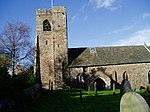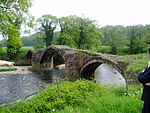Pendleton Brook
England river stubsLancashire geography stubsRivers of LancashireRivers of Ribble Valley

Pendleton Brook is a small river in Lancashire. The brook rises on Pendleton Moor and flows through the village of Pendleton, travelling north west to Higher Standen, then west past Standen Hall. From there, Pendleton Brook flows south of Clitheroe before meeting the River Ribble near Siddows.
Excerpt from the Wikipedia article Pendleton Brook (License: CC BY-SA 3.0, Authors, Images).Pendleton Brook
Henthorn Road, Ribble Valley
Geographical coordinates (GPS) Address Nearby Places Show on map
Geographical coordinates (GPS)
| Latitude | Longitude |
|---|---|
| N 53.8569 ° | E -2.42 ° |
Address
Henthorn Road
Henthorn Road
BB7 3BY Ribble Valley
England, United Kingdom
Open on Google Maps










